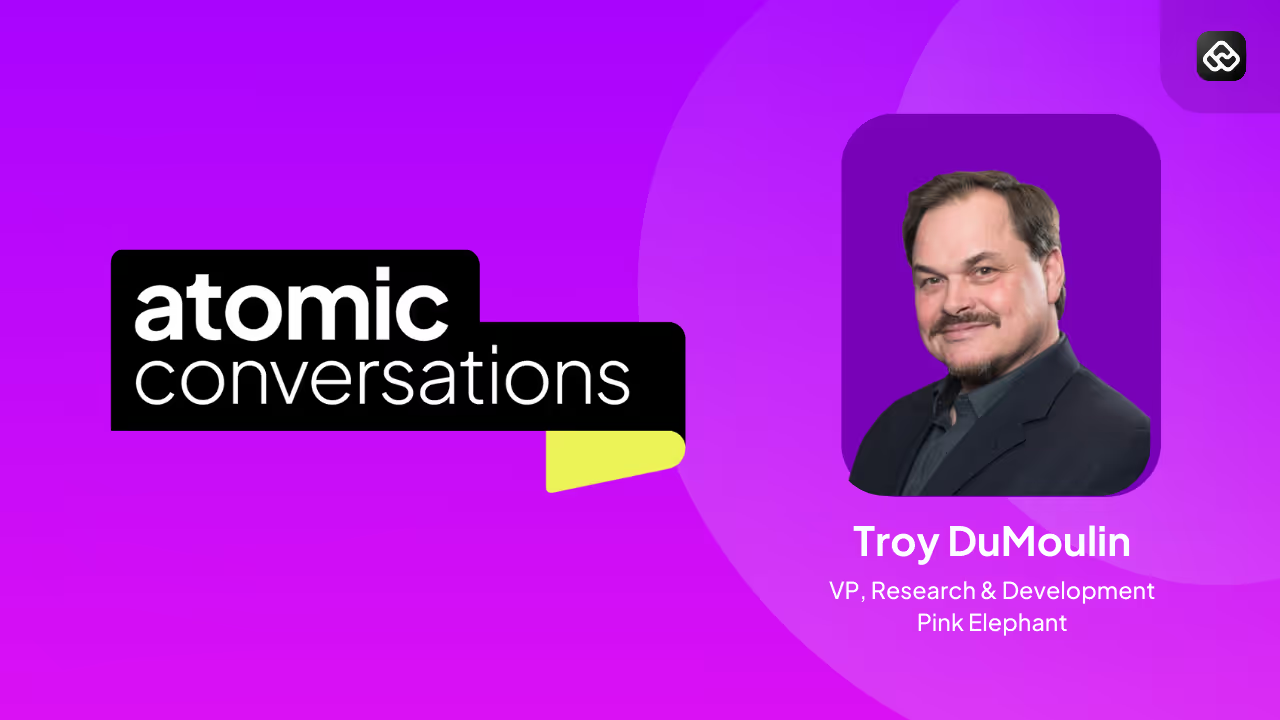

















Troy DuMoulin has watched technology cycles for 28 years.
He’s seen centralized computing give way to distributed systems, witnessed the mobile revolution, and guided organizations through cloud adoption. As VP of Research & Development at Pink Elephant, he's developed an eye for patterns in how transformative technologies take hold.
In this episode of Atomic Conversations, Troy DuMoulin sits down with Vijay Rayapati, CEO of Atomicwork, to share a sobering observation: AI isn’t following the usual playbook. Where previous technology transitions gave organizations 5-10 years to adapt, AI is compressing that timeline to just 12-24 months. And most IT leaders still don’t have a plan.
Watch the full conversation here or scroll for key highlights.
Troy’s analysis of AI transformation is grounded in a deep understanding of how technological disruptions unfold. Drawing on the work of Dr. Carlota Perez, a well-known researcher and lecturer specialized in the social and economic impact of technical change, Troy explains that all major technology shifts follow predictable patterns, regardless of whether they are digital technologies or broader innovations.
“The phases of these disruptions are repeating patterns,” Troy explains. The cycle begins with an “eruption period” where “only certain organizations have access to it, those which have high resources, research and development budgets or the organization that is engineering that technology from scratch.”
However, everything changes when venture capitalists discover the potential.
“The venture capitalists start to get wind of the technology, and this is the next big thing, and it’s going to be that possibility to make some form of major difference, whether it’s a cause or it’s for profit.”
This triggers the frenzy phase, where “the hype curve goes crazy at this moment, and everybody’s talking about it.”
But here’s the crucial insight: during frenzy, “there’s a lot of frenetic energy but not a lot of return on investment, because the funding at this point is venture funded, not on ROI. It’s on a promise.”
What makes AI fundamentally different from previous technology disruptions is the dramatically compressed timeline. Troy illustrates this with a sobering comparison to cloud computing.
Cloud transition offered organizations a comfortable window.
The transitional period, let’s call it that, was 5 to 8, maybe 10 years. But AI operates on an entirely different timeline. With AI, it is 12 to 24 months. - Troy DuMoulin, VP, Research & Development, Pink Elephant
This compression creates unprecedented urgency.
“The time we have to deal with this is alarmingly short, and most people are still not even realizing that this is going to happen or that we have entered the transitional phase.”
Adding complexity to this is the fact that different aspects of AI are at different stages, “There’s the idea of what’s called narrow AI or specialized AI, the underpinning automation that’s coming through the transitional phase, if not in synergy already for some organizations.”
The frenzy period inevitably leads to consolidation. This reset creates a fascinating dynamic between two types of organizations competing for dominance.
“There’s that ‘brick-and-mortar’ organization coming out from the previous major technology trying to reinvent itself and bolt on this new technology that is becoming the thing,” he explains. “Then there’s this organization that no one’s heard of before that’s been engineered and architected only on [the new technology], has no baggage, and they’re equally potentially disruptive.”
This is where the transition phase begins, “where actual organizations begin to adopt it and use it in certain use cases.”
The transition phase is make-or-break. “Those organizations that go into transition first and are successful come out the other side, take advantage. Then we have...those organizations that don’t go into the transition saying, ‘Oh, that's not real, it’s hype.”
The consequence is brutal, “That organization that exits the transitional phase first has that advantage, and they typically will take advantage of that and often those that stumble or do not even enter become basically the merger and acquisition targets of these organizations.”
Troy emphasizes that successful AI adoption requires comprehensive planning beyond technology, “They don’t have a people strategy and how to move their workforce and development of their people, skills and knowledge. They don’t have an organizational change plan, and that’s key because right now the majority of resistance for adoption is the people, right?”
Perhaps most concerning is Troy’s observation about IT leadership readiness.
Very few IT leaders actually have a deep understanding themselves. They’re expected to have an understanding by the people that fund their organizations.
This knowledge gap creates a dangerous delay. “They need to immediately begin digging deep into the ramifications of large language models and AI and Gen AI and all of that context of how that underpins their key solutions, how that’s going to impact digital strategy, which is greater than IT strategy, right?”
Many IT leaders find themselves in positions where they must drive strategy from the bottom up.
DuMoulin’s most powerful insight challenges conventional technology implementation approaches. The real barrier isn’t technological.
It’s not a technology constraint, it’s not a process constraint because the processes are embedded within the technology. It’s a people question. The adoption hesitation is not because the tool doesn’t do great things, it’s because people aren’t being brought along.
As AI transforms the technology landscape, human roles are evolving, not disappearing. Troy notes how AI is taking over a task but needs humans in the loop for validation, subject matter expertise, critical thinking, empathy, and wisdom to apply the information.
Troy’s message to IT leaders is unambiguous. “The frenzy is always followed by transition and synergy. So it’s not a question of if, just the when is much shorter than we’ve ever had before.”
The compressed timeline means there’s no luxury of extended planning periods. Organizations must act now, develop comprehensive strategies that prioritize people alongside technology, and treat AI adoption as the organizational transformation it truly is.
With the transition window compressed to just 12-24 months, the choice is stark: lead the AI transition or risk becoming a casualty of it. The time for action is now.
You can catch the full discussion here.




